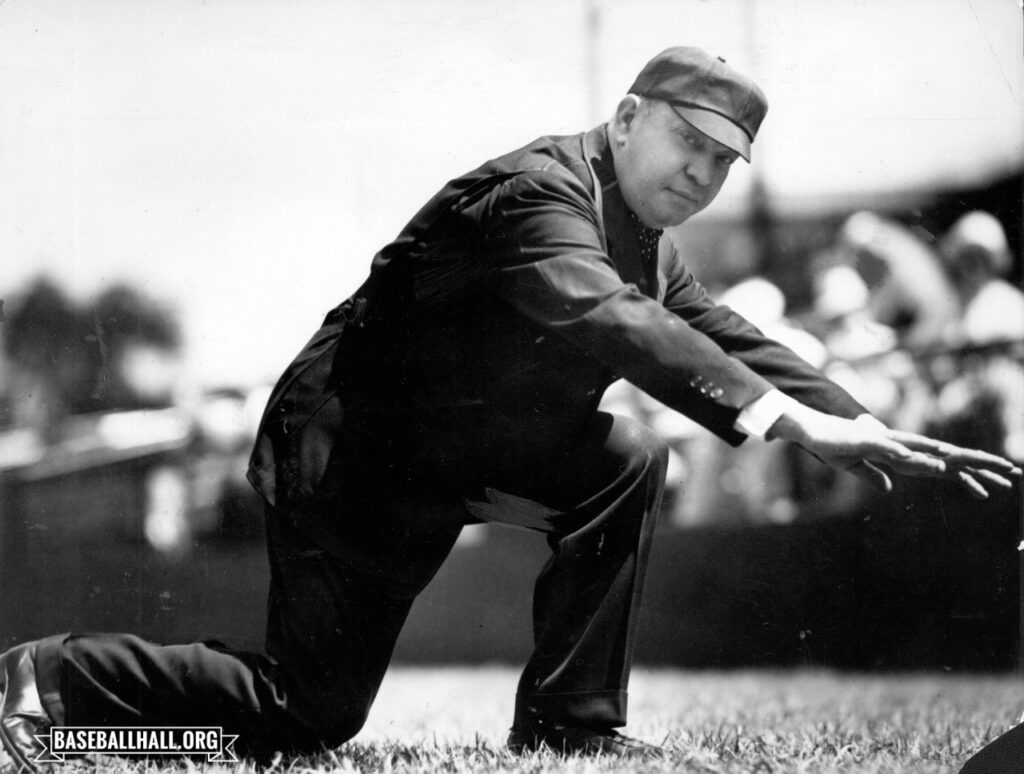Scroll Down to Read Today’s Essay
Subscribe to Baseball History Comes Alive for automatic updates. As a Free Bonus, you’ll get instant access to my Special Report: Gary’s Handy Dandy World Series Reference Guide!
Today we welcome the first guest submission from our loyal reader, Thomas Marshall. Tom has become our “go-to-guy” for all things umpire-related! In this two-part series, Tom tell us that umpire hand signals found their origin in accommodating deaf players in the mid-eighteenth century. I enjoyed Tom’s trip through this bit of baseball history and I think you will too! -GL
A Historical Look at Umpire Signals and Deaf MLB Players
I retired from 29 years of umpiring youth and high school baseball, and whenever I watch a game, I pay just as much attention to the “Third Team” as I do the action of the players. I love watching any baseball game on TV, but I enjoy being in a stadium the most, where I can observe the actions of the umpires. After each play, we look to the umpire’s signal to learn the call. Ever wonder how and why those signals got started?
Most baseball fans are familiar with the most common physical signals and/or gestures of the umpires: Out, safe, fair ball, foul, time, strike, ball, etc. There are also many more not-so-common ones, such as foul tip, un-caught third strike, obstruction, and interference. Umpire crews also utilize their own signals to indicate such things as a potential time play, rotations, and the infield fly rule. These are done discreetly, hardly ever noticed by players, coaches or fans. Recently, to enforce the new rules (step-offs, pitch clock, batter timeouts, etc.) the umpires have had to incorporate even newer signals.
Some may find it hard to believe, but there was a time during the genesis of baseball when umpires used no hand or arm signals. The decisions and rulings were all done vocally.
History tells us that baseball began to be played in the United States with increasing regularity during the Civil War. In the various schools for the deaf in existence at that time, the teachers at these schools believed that athletics should be an important part of their curriculum, including baseball. In 1865, Parley Pratt was a deaf teacher and umpire/coach who taught his students baseball at the Columbus, Ohio Institute for the Deaf. Pratt used common gestures of American Sign Language (ASL) in officiating his students’ games. For example, a common deaf sign for “get rid of it”, or “no good” was to extend the right hand, as in a handshake, with the thumb extended upward, and then thrusting the hand over the right shoulder. Pratt used that gesture to signal “out,” the beginning of the traditional “out” signal that we know today.
As for the safe signal, when something was “free,” or “not-to-worry,” the deaf sign was to extend both arms out in front of your midsection, with palms down, and then cross your hands over each other back and forth. This evolved into today’s “safe” signal.
Soon after the formation of the National League in 1876, the first professional deaf player was pitcher Ed “Dummy” Dundon, who had a short, two-year career with the Columbus Buckeyes (1883-84). Dundon had learned the umpire signals from Pratt while a student at the Ohio Institute.
The team from the Ohio Institute initially played sandlot ball. Eventually, it expanded into a semi-pro touring team known as the “Ohio Independents,” playing against other deaf (and also hearing) teams. In 1879, the Independents toured some 3,5000 miles, playing other semi-pro teams, compiling a 44-7 record.
Hand signals were later adapted in 1901 by the Chicago White Sox of the newly-formed American League for the benefit of their deaf player, William “Dummy” Hoy. He had been a student at the Ohio Institute and learned baseball-related signals from Coach Pratt and Dummy Dundon. Hoy played center field for eight major league teams (1888-1902) and taught ASL to as many of his teammates and coaches.
Early in his career, pitchers regularly tried to “quick-pitch” Dummy as he was looking back behind him at the umpire to see whether the pitch was a ball or strike. His batting average suffered as a result. Eventually, it became less difficult for him if his third base coach gave him the ball-strike signal. A quick glance to third base without having to turn his head around made it much easier. The first year after using this method, his batting average improved to .367!
(To be continued…)
Tom Marshall
Subscribe to our website, Baseball History Comes Alive with over 1400 fully categorized baseball essays and photo galleries, now surpassing the one million hits mark with 1,120,000 hits and over 950 subscribers: https://wp.me/P7a04E-2he
Information: Excerpts edited from

